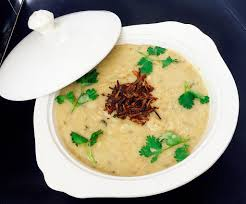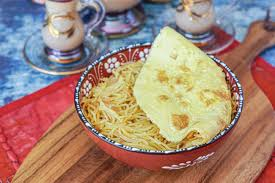Traditional Kuwaiti food is not just about rich spices and bold flavors. It reflects centuries of culture, storytelling, and family traditions that have been passed down through generations. From the coastal influences of the Arabian Gulf to the hearty meals of the desert dwellers, every dish in Kuwait has a tale to tell.
Let’s explore seven amazing traditional Kuwaiti food dishes and the fascinating stories behind them. These dishes are not only favorites in households across Kuwait but also important cultural symbols of hospitality and identity.
1. Machboos – The Heart of Kuwaiti Tables
Machboos is the national dish of Kuwait. It is a fragrant rice-based dish made with basmati rice, meat (usually chicken, lamb, or fish), and a blend of spices known as baharat. The rice is often cooked in the same broth as the meat, allowing deep flavor to develop.
Story Behind the Dish:
Machboos represents celebration and unity. It is the centerpiece of gatherings, from weddings to Eid feasts. The dish originated from the pearl diving communities who would cook large meals for communal sharing after long days at sea.
2. 2. Harees – A Meal from the Past

Harees is a porridge-like dish made from wheat and meat, slowly cooked until smooth. It is commonly served during the holy month of Ramadan and on special occasions.
Story Behind the Dish:
Harees is a dish of patience. In old Kuwait, this meal was prepared overnight in clay pots, especially during Ramadan. Families believe it brings blessings when shared with neighbors and the poor, embodying the Islamic value of charity.
3. Mutabbaq Samak – Flavors from the Sea
Mutabbaq Samak is a rice and fish dish. The fish, usually zubaidi (silver pomfret), is seasoned, fried, and served over rice cooked with dried lime (loomi) and spices.
Story Behind the Dish:
Due to Kuwait’s location on the coast, fishing was one of the main occupations. Zubaidi was considered a luxury fish reserved for important guests. Serving Mutabbaq Samak was a symbol of status and respect.
4. Jireesh – Comfort in Simplicity
Jireesh is made of crushed wheat cooked with meat, tomatoes, and spices until soft. It has a porridge-like consistency and is often eaten during winter.
Story Behind the Dish:
Jireesh was a common dish among Bedouins and desert dwellers. Its ingredients were easy to store and cook while traveling. Over time, it became a comfort food in Kuwaiti homes, especially for the elderly and children.
5. Margoog – A Dish of the Desert
Margoog is a stew made with lamb, vegetables, and thin slices of wheat dough that resemble pasta. It is rich, flavorful, and deeply satisfying.
Story Behind the Dish:
Margoog originated in the deserts of the Arabian Peninsula. The dough represented an innovation by women who found ways to stretch ingredients. It’s now considered one of the most wholesome traditional Kuwaiti food dishes.
6. Gabout – Stuffed Dumplings of the Gulf
Gabout are dumplings filled with minced meat and cooked in a tomato-based broth. The dough is soft and absorbs all the flavors of the stew.
Story Behind the Dish:
This dish was a favorite during cooler seasons. Mothers and grandmothers would teach younger generations to prepare the delicate dumplings, making it both a meal and a family tradition.
7. Balaleet – Sweet Meets Savory

Balaleet is a sweet-and-savory breakfast dish made with vermicelli sweetened with sugar, saffron, and cardamom, topped with an omelet.
Story Behind the Dish:
This surprising combination was often served during Eid mornings. It reflects the Kuwaiti love for combining contrasting tastes. Many believe it represents balance in life – sweet and salty, morning and night, tradition and change.
Why Traditional Kuwaiti Food Still Matters Today
Traditional Kuwaiti food connects the present generation with the past. In a rapidly modernizing society, these recipes remain untouched and serve as reminders of Kuwait’s humble beginnings and cultural richness. Each dish represents values like hospitality, resilience, and togetherness.
Even today, during Ramadan, weddings, or Friday family gatherings, these meals are prepared and shared with pride. Cooking methods are taught from parents to children, ensuring that the essence of Kuwaiti culture lives on through food.
The Cultural Impact of Kuwaiti Cuisine
Kuwaiti food is more than just what is served on a plate. It reflects influences from Persian, Indian, and Arabian cultures due to Kuwait’s history as a trade hub. This has led to a unique blend of spices and techniques, yet with a strong Kuwaiti identity.
Many restaurants in Kuwait still serve traditional food in traditional settings, allowing locals and visitors to experience both taste and history. Food festivals and cooking shows often highlight these dishes, encouraging young chefs to embrace heritage while adding a modern twist.
Conclusion
Traditional Kuwaiti food is a window into the country’s soul. From celebratory meals like Machboos to humble dishes like Jireesh, every bite tells a story of family, faith, and culture. If you’re exploring the Middle East or want to learn more about Arab cuisine, these dishes offer a warm and flavorful starting point.
They’re not just recipes—they are memories, values, and the flavor of Kuwaiti life.
Also Read – 10 Must-Try Popular Kuwaiti Food Dishes in 2025



